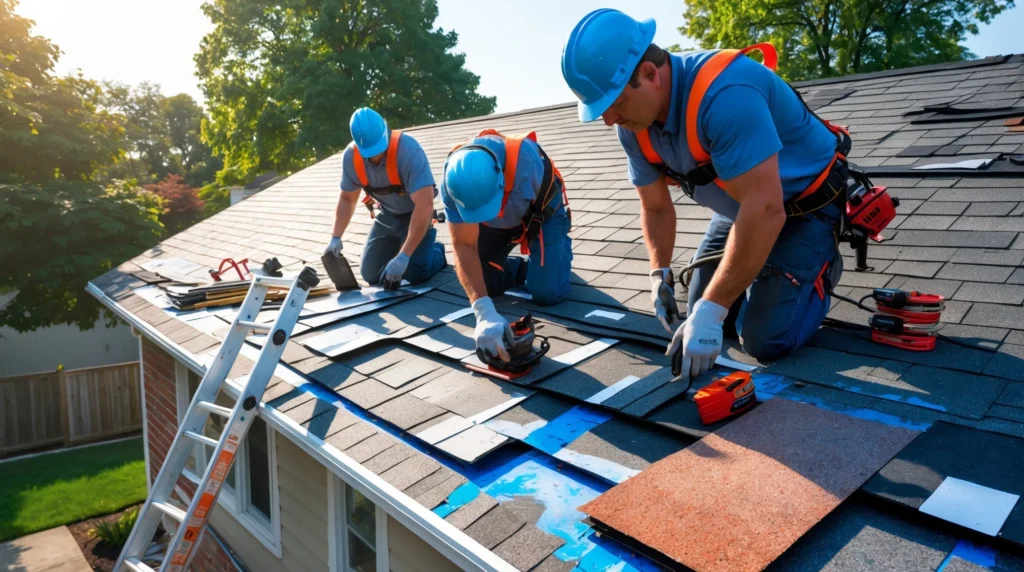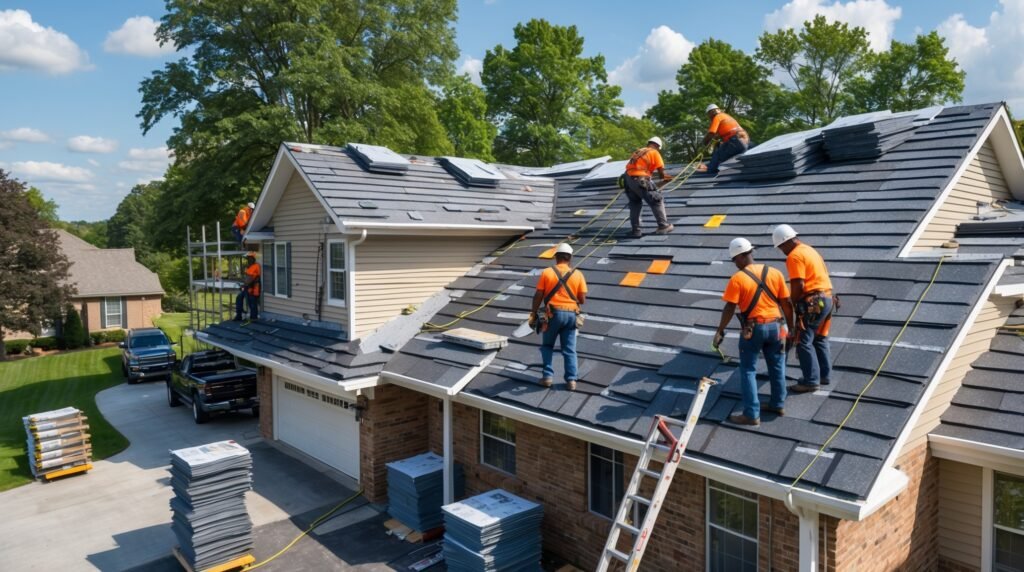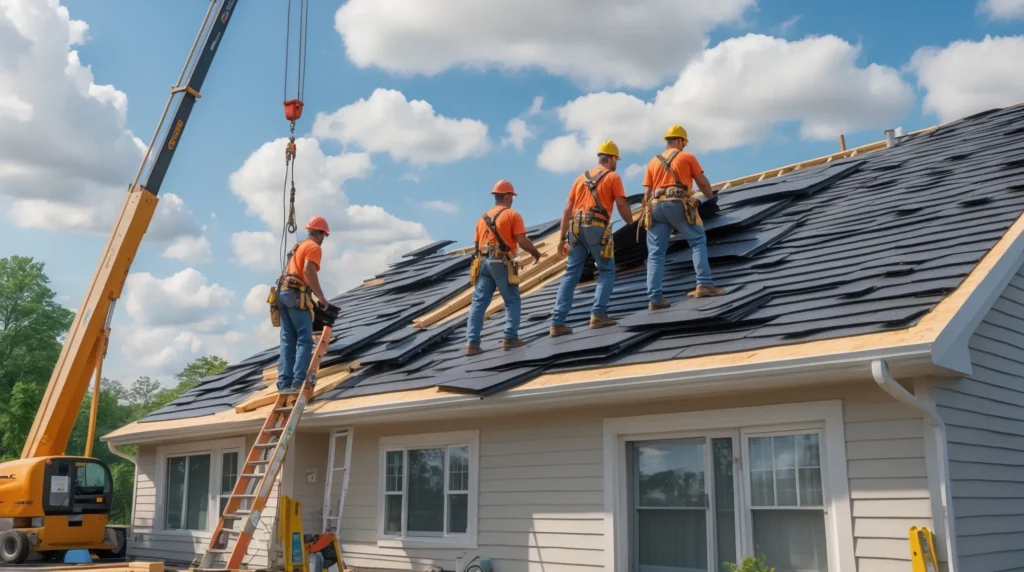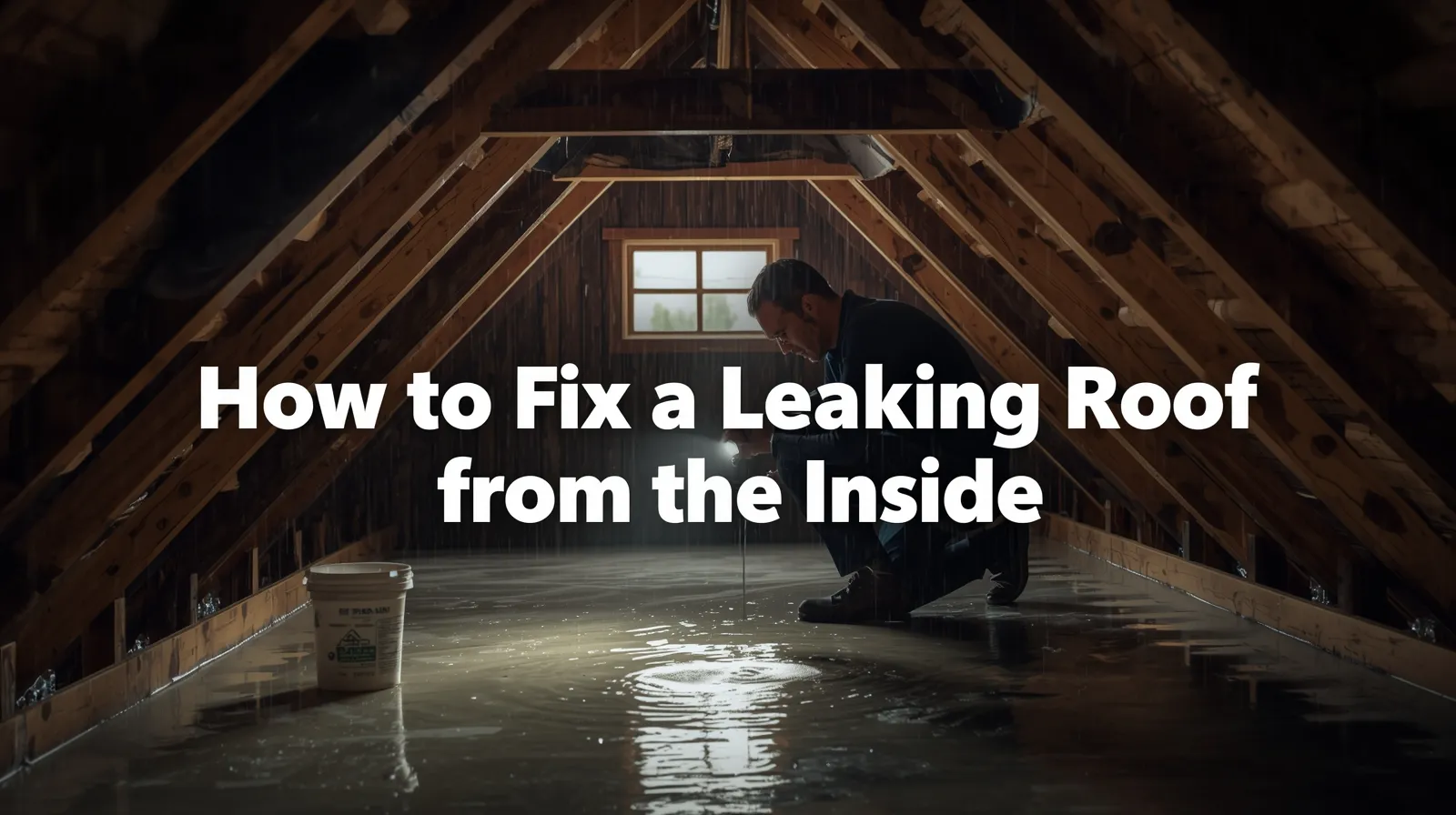When you first notice a problem with your roof whether it’s a missing shingle, a slow leak, or visible sagging your mind immediately jumps to how long the repair will take. This is especially true if the damage could cause water to enter your home or further weaken the structure. The truth is, the timeline for roof work varies widely.
Small-scale fixes, like sealing minor leaks or replacing a few shingles, can often be handled in a single morning or afternoon. Larger repairs that involve sections of decking, multiple layers of shingles, or structural adjustments may require two or more days.
Planning ahead is essential. If you understand the basic process, you can prepare for the noise, crew presence, and temporary disruptions. By knowing how long does it take to repair a roof under different conditions, you can make informed decisions, set realistic expectations, and prevent delays that could leave your home exposed to the elements.
Roof Repair vs. Replacement: Why Timelines Differ (roof replacement timeline basics)
One of the first steps in estimating how long your roofing project will take is determining whether you need a repair or a full replacement. Repairs typically focus on one problem area, which makes them faster and less disruptive.
Repairs
- Usually target a single leak, damaged flashing, or a small patch of missing shingles
- Can often be completed in a few hours or half a day
- Rarely require permits, unless structural changes are needed
Replacements
- Require removing the old roofing material entirely
- May involve replacing damaged decking or underlayment
- Take longer because the entire surface is addressed, not just a section
Roof replacement time is longer because each step must be completed in sequence. There’s also a greater chance of discovering hidden issues once the old material is removed. This is why a roof replacement timeline may range from two days to a week or more, depending on the home’s size, slope, and material type.
How Long Does It Take to Repair a Roof? Typical Fixes and Durations

For many homeowners, the most pressing question is: how long does it take to repair a roof if the problem isn’t too severe? The answer depends on the repair type:
- Minor leak repair – 2–4 hours
- Replacing a few shingles – 1–2 hours
- Flashing replacement – 3–5 hours
- Small section decking replacement – 1 day
- Storm damage repair – 1–2 days, depending on severity
The crew size plays a big role. A two-person team will naturally take longer than a crew of six, especially on larger or steeper roofs. Accessibility also matters homes surrounded by trees, fencing, or limited driveway space may require extra time to move materials and equipment into place.
Shingle Work: How long does it take to replace roof shingles or reshingle a section?
Shingle repairs are among the most common roofing jobs. If you’re simply replacing a handful of shingles lost in a storm, the work might take less than an hour. However, if you need to reshingle an entire slope of your roof, the timeline changes dramatically.
Factors that influence shingle replacement time:
- Material type: Asphalt shingles are quick to install, while slate or wood shakes take longer.
- Roof pitch: Steeper slopes require more safety measures, slowing the crew.
- Damage extent: A simple overlay is faster than a full tear-off and replacement.
On average, reshingle work for a medium-sized section of roof can take a full day. This includes removing damaged shingles, inspecting the underlayment, and installing the new layer securely.
How Long Does a Roofing Job Take? Crew Size, Slope, Material, and Access

When asking how long does a roofing job take, think beyond just the number of hours. Every project has its own unique mix of factors:
- Crew Size – Larger crews work faster, especially on big roofs.
- Roof Slope – Steeper roofs slow the process and require safety harnesses and extra care.
- Material Weight – Heavier materials like clay tile or slate require more time for lifting and placement.
- Access Points – Easy driveway and yard access help move materials efficiently.
- Prep Work – Clearing debris, removing old roofing, and setting up ladders/scaffolding takes time.
A straightforward asphalt shingle roof on a single-story home might take just a day or two. More complex structures can stretch timelines to a week or more.
Can a Roof Be Replaced in One Day? When It’s Realistic (and When It’s Not)
Many homeowners are curious about can a roof be replaced in one day. The short answer: yes, but only in certain situations.
Possible in one day if:
- The roof is small (less than 2,000 square feet)
- The design is simple (no complex valleys or dormers)
- Weather is clear and dry
- The crew is large and highly experienced
Not realistic if:
- The roof has multiple slopes or complex designs
- The material is heavy, like tile or slate
- Hidden damage is discovered after removing old materials
- Weather interrupts the work
One-day replacements are the exception, not the rule. Most projects benefit from a steady, careful approach to ensure quality.
Average Roof Replacement Time: How Many Days to Replace a Roof?
Replacing a roof is a multi-step process. The average roof replacement time is generally between 2 and 5 days, but here’s why:
Step-by-step process:
- Preparation – Setting up ladders, safety lines, and material staging (1–2 hours)
- Tear-off – Removing the old roof layer(s) (½ to 1 day)
- Repairs – Fixing decking, flashing, or other underlying issues (varies)
- Installation – Placing underlayment and new shingles/tiles (1–2 days)
- Cleanup – Removing debris and magnetic sweeping for nails (½ day)
Roof size, complexity, and weather will determine how many days to replace a roof.
How Long Does It Take to Put On or Install a New Roof? End-to-End Steps

Installing a new roof involves more than just nailing shingles. From inspection to final cleanup, the how long does it take to put on a roof question depends on each stage:
- Initial inspection & measurements – 1–2 hours
- Ordering & delivering materials – 1–3 days (longer for special orders)
- Tear-off – 1 day for most homes
- Installation – 1–3 days depending on size/material
- Final inspection & cleanup – ½ day
From the first appointment to the finished roof, you might be looking at a total of 5–10 days, factoring in preparation, delivery, and potential weather delays.
Local Factors in Hillsboro: Weather, Permits, and Inspections Affecting How Long to Reroof a House
In Hillsboro, local climate plays a big role in scheduling roofing work. Frequent rain can push back start dates and interrupt ongoing projects. Roofing contractors often monitor weather forecasts closely to avoid tearing off a roof just before a storm.
Permit processing time can also impact the how long to reroof a house timeline. While simple repairs may not require a permit, replacements often do. Final inspections are another consideration, and scheduling them promptly helps avoid delays.
Working with a trusted local company like FONZ Construction ensures these local factors are accounted for in your project plan, helping you finish on time.
Planning Your Roof Repair Timeline: When to Schedule with FONZ Construction
If you’re trying to figure out the best time for roof work, start by thinking about weather, material availability, and your personal schedule. Spring and early fall are often ideal for roofing in many areas, offering mild temperatures and fewer weather interruptions.
Booking your project early with FONZ Construction can secure your preferred time slot. This is especially important during peak roofing season when contractors fill their calendars quickly. Clear communication and realistic expectations make for a smoother process from start to finish.
If your roof is showing signs of wear or has been damaged in a storm, don’t wait until small problems become costly repairs. Call our team today to schedule an inspection and get your home protected without unnecessary delays.


